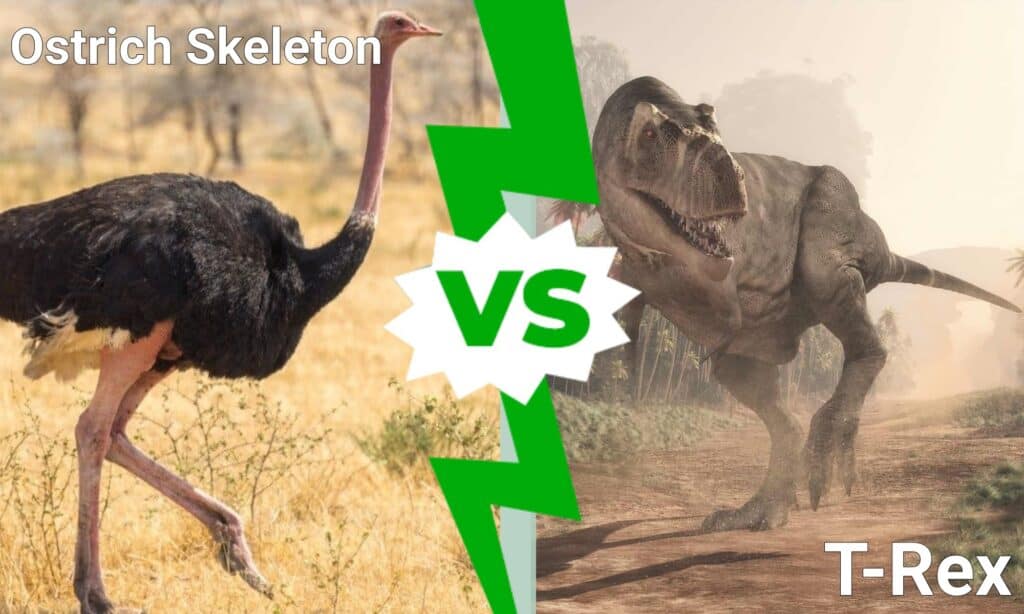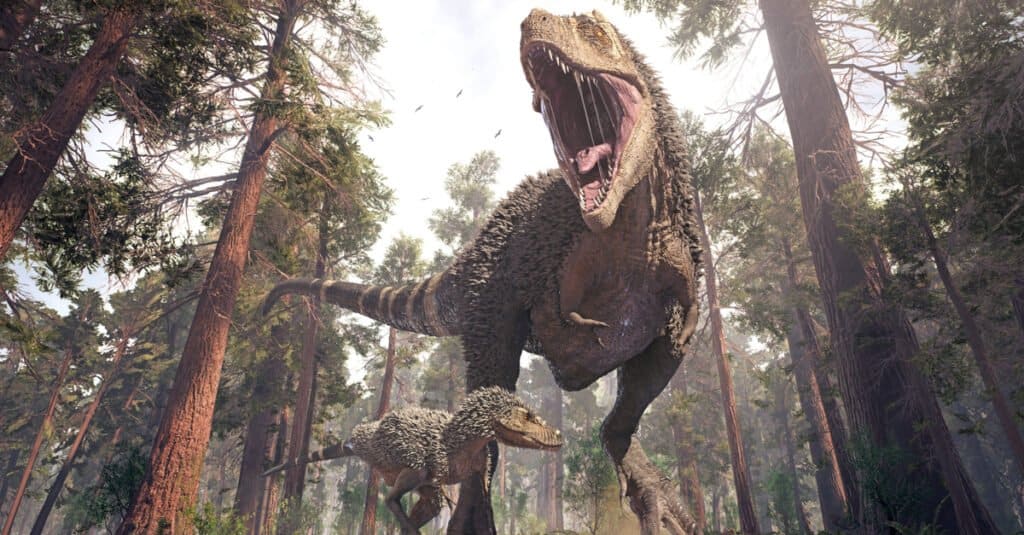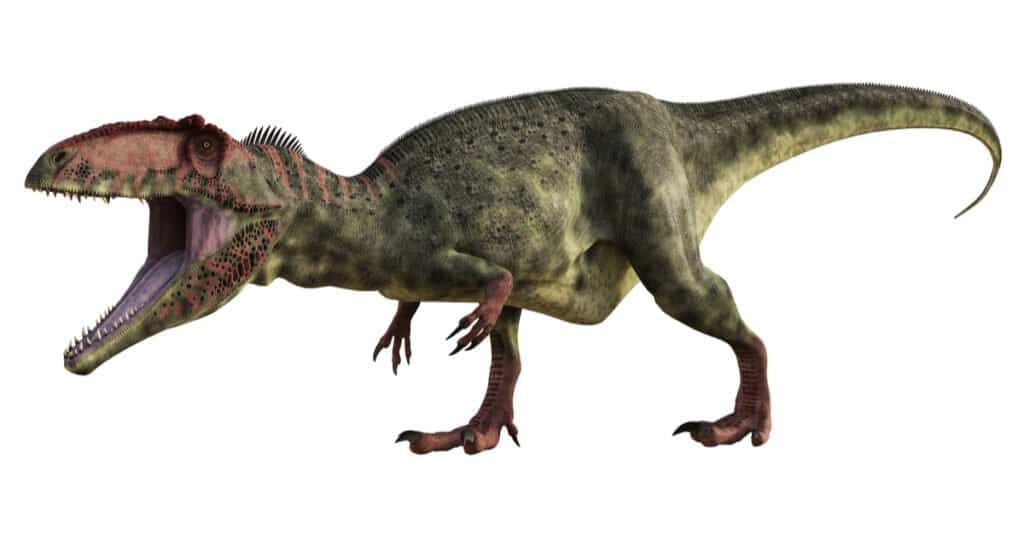Scientists may or may not have discovered that there are a number of similarities between an ostrich skeleton vs T-Rex, but are the studies true? Just how similar was the skeleton of a T-Rex compared to the modern-day skeleton of an ostrich? If you’ve always wanted to learn more about the skeletal structure of the T-Rex, you’re in the right place.
In this article, we will go over whether or not the T-Rex is an ancient ancestor of the ostrich. We will also compare and contrast their skeletal structures to confirm whether or not these two creatures are related. Finally, we will address whether or not the T-Rex is closely related to other animals that are alive today. Let’s get started now!
Comparing Ostrich Skeleton vs T-Rex

| Ostrich Skeleton | T-Rex | |
|---|---|---|
| Size | 6-9 feet tall; neck and legs make up most of its height | 12-15 feet tall; body makes up most of its height |
| Bone Composition | All hollow; makes up less than 10% of its body weight | Some hollow; makes up more than 20% of its body weight |
| Arms and Legs | Small wings, with a wingspan of 5-7 feet across; incapable of flight. Legs range in length and end in three sharp toes | Small clawed arms and hands; hardly useful, given the size of the average T-Rex. The longest legs compared to body size of any other theropod, with three toes |
| Presence of Feathers | Yes, on main part of body and some down on their heads | Possibly, but only on certain sections of the body |
| Skull Shape | Extremely small and pyramid or triangular in shape. Large eye holes and mostly pneumatic bones (full of tiny holes) | Huge skull with multiple openings in bones to reduce weight, as well as some pneumatic bones. Large eye holes and narrow skull for seeing well |
Key Differences Between Ostrich Skeleton vs T-Rex

The skeletal structure of the ostrich is much lighter than the skeletal structure of the T-Rex.
©bruna-nature/Shutterstock.com
There are a number of differences between an ostrich skeleton and a T-Rex skeleton. While they may have a similar shape upon first glance, the ostrich skeleton only measures 6 to 9 feet tall, while the T-Rex skeleton measures 12 to 15 feet tall. Additionally, the skeletal structure of the ostrich is much lighter than the skeletal structure of the T-Rex, though both of these creatures have hollow bones.
But this is only the beginning in terms of the similarities and differences between these two creatures. Let’s continue our comparison in more detail now.
Ostrich Skeleton vs T-Rex: Size

The average T-Rex skeleton measures 12 to 15 feet tall from the hip bone, while the average ostrich measures 6 to 9 feet tall, including their very long necks.
©Herschel Hoffmeyer/Shutterstock.com
One of the primary differences between the T-Rex skeleton and the ostrich skeleton has to be the sheer size of the T-Rex. While the ostrich is one of the largest flightless birds in the world, the T-Rex is significantly larger in every way. For example, the average T-Rex skeleton measures 12 to 15 feet tall from the hip bone, while the average ostrich measures 6 to 9 feet tall, including their very long necks.
It is also interesting to note that the ostrich earns its height from its legs and neck, while the T-Rex also has extraordinarily long legs compared to its family of dinosaurs. However, the neck of the T-Rex isn’t nearly as long as the neck of the ostrich, and the overall size of the average T-Rex has much to do with the length of their tail, something that the ostrich does not share.
Ostrich Skeleton vs T-Rex: Bone Composition

The ostrich’s skeleton makes up less than 10% of its overall body weight, while a T-Rex skeleton makes up at least 20% of its overall body weight, if not far more.
©Sergei25/Shutterstock.com
Scientists have often believed that T-Rexes are the ancestors of modern birds because of their bone composition. Both ostriches and T-Rexes have hollow bones, at least to some extent. However, the ostrich has more hollow bones compared to the average T-Rex. But how exactly does this make a difference in the skeletal structure of both the T-Rex and the ostrich?
Given the fact that the T-Rex doesn’t have as many hollow bones as the ostrich means that the skeleton of the T-Rex is much heavier when compared to the overall body weight of this dinosaur, which is not the case with the ostrich. In fact, the ostrich’s skeleton makes up less than 10% of its overall body weight, while a T-Rex skeleton makes up at least 20% of its overall body weight, if not far more.
Ostrich Skeleton vs T-Rex: Arms and Legs

The ostrich wingspan is only 5 to 7 feet across, which makes it impossible for this bird to fly, while T-Rex arms are essentially useless compared to the body size of a T-Rex.
©Herschel Hoffmeyer/Shutterstock.com
Another reason why T-Rexes are often compared with ostriches is the fact that they both have extremely small arms or wings compared to other creatures and the rest of their body. For example, the ostrich wingspan is only 5 to 7 feet across, which makes it impossible for this bird to fly, while T-Rex arms are essentially useless compared to the body size of a T-Rex.
However, it is the legs of both of these creatures that makes scientists pause. Both the ostrich and the T-Rex have extraordinarily long legs, capable of propelling both of these creatures forward at up to 40 mph. In fact, the stride of the ostrich has been studied alongside the possible stride of the T-Rex, and there are many similarities between the two creatures in terms of the way they walked and ran!
Ostrich Skeleton vs T-Rex: Presence of Feathers

Some research suggests that yes indeed, the T-Rex was partially feathered, but only on a certain portion of its body, though the ostrich likely has more feathers overall.
©NileshShah/Shutterstock.com
You no doubt know that the ostrich is covered in rich black and white feathers, but can the same also be said of the T-Rex? This is another hotly debated fact in the scientific community, as paleontologists struggle to find out whether or not the T-Rex was actually feathered. Some research suggests that yes indeed, the T-Rex was partially feathered, but only on a certain portion of its body, though the ostrich likely has more feathers overall.
Ostrich Skeleton vs T-Rex: Skull Shape

The skull of the ostrich is triangular or more pyramidal in shape compared to the more rectangular skull of the T-Rex.
©Orla/Shutterstock.com
There are very few comparisons between the skull shape of the ostrich in the skull shape of the T-Rex. Powerful jaws and terrifying teeth aside, the skull of the ostrich is triangular or more pyramidal in shape compared to the more rectangular skull of the T-Rex. However, both of these creatures have extremely large holes in their skulls for their eyes. Both the T-Rex and the ostrich have some of the largest eyes of any other land-dwelling creature!
The photo featured at the top of this post is © muhd fuad abd rahim/Shutterstock.com
Thank you for reading! Have some feedback for us? Contact the AZ Animals editorial team.






